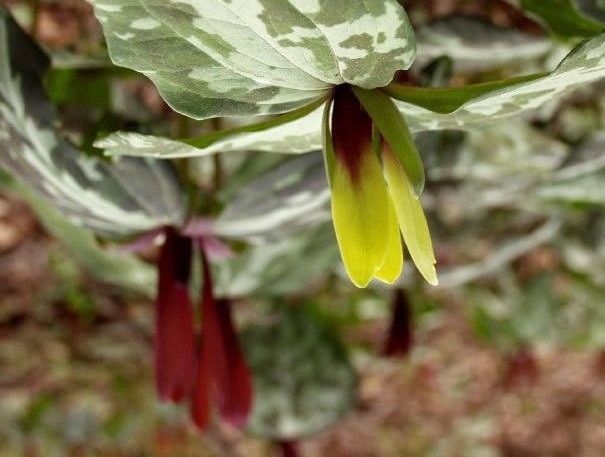Wateree trillium
(Trillium oostingii)

Description
Trillium oostingii, commonly known as Wateree trillium, is a species of flowering plant in the family Melanthiaceae. It is endemic to the central part of the US State of South Carolina. Wateree trillium grows under a canopy of deciduous trees such as bitternut hickory, black walnut, slippery elm, box-elder, and various oak species, in rich floodplain soils. Here it forms large colonies alongside mayapple, another spring-flowering herb. Wateree trillium most closely resembles the sessile-flowered trilliums, T. lancifolium and T. recurvatum, but is distinguished from these chiefly by floral anatomy. In T. oostingii, the anthers are only slightly incurved (curved toward the center of the flower) and have much shorter filaments, resulting in a more compressed look. According to DNA sequence analysis, T. oostingii is more distantly related to either of these species than they are to each other. Wateree trillium has three broadly rounded, mottled leaves atop a single, 10–30 cm stem. Its flowers have three green-yellow petals and three green to maroon sepals. Trillium (trillium, wakerobin, toadshade, tri flower, birthroot, birthwort, and sometimes "wood lily") is a genus of about fifty flowering plant species in the family Melanthiaceae. Trillium species are native to temperate regions of North America and Asia, with the greatest diversity of species found in the southern Appalachian Mountains in the southeastern United States. Plants of this genus are perennial herbs growing from rhizomes. There are three large leaf-like bracts arranged in a whorl about a scape that rises directly from the rhizome. There are no true aboveground leaves but sometimes there are scale-like leaves on the underground rhizome. The bracts are photosynthetic and are sometimes called leaves. The inflorescence is a single flower with three green or reddish sepals and three petals in shades of red, purple, pink, white, yellow, or green. At the center of the flower there are six stamens and three stigmas borne on a very short style, if any. The fruit is fleshy and capsule-like or berrylike. The seeds have large, oily elaiosomes. Occasionally individuals have four-fold symmetry, with four bracts (leaves), four sepals, and four petals in the blossom.. The tetramerous condition has been described for several species of Trillium including T. chloropetalum, T. erectum, T. grandiflorum, T. maculatum, T. sessile, and T. undulatum.
Taxonomic tree:







